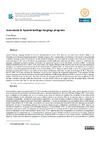Please use this identifier to cite or link to this item:
https://accedacris.ulpgc.es/handle/10553/77390
| DC Field | Value | Language |
|---|---|---|
| dc.contributor.author | Burgo, Clara | en_US |
| dc.date.accessioned | 2021-01-30T09:23:23Z | - |
| dc.date.available | 2021-01-30T09:23:23Z | - |
| dc.date.issued | 2020 | en_US |
| dc.identifier.issn | 2340-8561 | en_US |
| dc.identifier.uri | https://accedacris.ulpgc.es/handle/10553/77390 | - |
| dc.description.abstract | Spanish heritage language learners (HLLs) are heterogeneous in nature. Thus, how can we assess these students? Most of the literature on this has been on placement exams (Polinsky & Kagan, 2017, among others), but the focus of this article is on assessment in Spanish heritage courses. Placement test results should be indicators of what should be included in the curriculum. One of the main challenges is the lack of the following components: specific proficiency indicators for HLLs, consensus in defining key concepts, understanding dialect variation, assessment for measuring linguistic skills, and finally research on HLLs’ assessment (Malone, Kreeft Peyton, & Kim, 2014). Thus, assessment is the biggest challenge in HL education due to the dominant monolingual ideologies, so formative assessment practices are recommended to confront them by allowing HLLs to negotiate their linguistic identities via multilingual perspectives (King, Liu, & Schwedhelm, 2018). What are specific tools or activities to negotiate these? Personal narratives of US Latinos were collected by Carreira and Beeman (2014) for the sake of reflections of HLLs as language brokers. González-Davies (2004, 2018) also mentions the importance of peer-to-peer strategies for translation competence. These projects can also become group projects, like the manifestos implemented by Moreno and MacGregor-Mendoza (2019) in a course in which language, culture, and community are the goals. All these activities are examples of the kinds of assessment that may be effective in the heritage classroom and may guide their instructors. The goal of this article is to suggest activities to connect HLLs with their communities at the same time that their learning gains are assessed in terms of language proficiency. | en_US |
| dc.description.abstract | Los aprendices como lengua de herencia (ALH) de español son heterogéneos en naturaleza. Por tanto, ¿cómo podemos evaluar a estos estudiantes? La mayoría de la literatura sobre esto ha sido sobre exámenes de ubicación (Polinsky & Kagan, 2017, entre otros), pero el enfoque de este artículo está en la evaluación en los cursos de herencia de español. Los resultados de los exámenes de ubicación deberían ser los indicadores de lo que se debería incluir en el currículo. Uno de los mayores retos es la falta de los siguientes componentes: indicadores de proficiencia específicos a los ALH, consenso al definir conceptos clave, comprender la variación dialectal, evaluación para medir habilidades lingüísticas, y finalmente investigación en la evaluación de los ALH (Malone, Kreeft Peyton, & Kim, 2014). Por tanto, la evaluación es el mayor reto en la educación como LH debido a las ideologías monolingües dominantes, así que se recomiendan prácticas de evaluación formativa para confrontarlas permitiendo a los ALH negociar sus identidades lingüísticas vía perspectivas multilingües (King, Liu, & Schwedhelm, 2018). ¿Cuáles son las herramientas o actividades especifícas para regular estas? Se recogieron las narrativas personales de los latinx de EEUU por Carreira and Beeman (2014) en busca de reflexiones de los ALH. González-Davies (2004, 2018) también menciona la importancia de estrategias de compañero a compañero para la competencia de la traducción. Estos proyectos pueden además convertirse en proyectos de grupo, como los manifiestos implementados por Moreno and MacGregor-Mendoza (2019) en un curso en cuya lengua, cultura y comunidad son los objetivos. Todas estas actividades son ejemplos de los tipos de evaluación que podrían ser efectivos en el aula de herencia y podrían guiar a los instructores. El fin de este artículo es sugerir actividades para conectar a los ALH con sus comunidades a la vez que su aprendizaje se evalúa en términos de proficiencia lingüística. | en_US |
| dc.language | eng | en_US |
| dc.relation.ispartof | LFE. Revista de Lenguas para Fines Específicos | en_US |
| dc.source | LFE. Revista de lenguas para fines específicos [eISSN 2340-8561], v. 26 (2), p. 101-110 | en_US |
| dc.subject | 570510 Sociolingüística | en_US |
| dc.subject.other | Evaluación | en_US |
| dc.subject.other | Competencia lingüística | en_US |
| dc.subject.other | Narrativas personales | en_US |
| dc.subject.other | Assessment | en_US |
| dc.subject.other | Language proficiency | en_US |
| dc.subject.other | Personal narratives | en_US |
| dc.title | Assessment in Spanish heritage language programs | en_US |
| dc.type | info:eu-repo/semantics/article | en_US |
| dc.type | Article | en_US |
| dc.description.lastpage | 110 | en_US |
| dc.description.firstpage | 101 | en_US |
| dc.relation.volume | 26 | en_US |
| dc.investigacion | Artes y Humanidades | en_US |
| dc.type2 | Artículo | en_US |
| dc.identifier.ulpgc | Sí | en_US |
| dc.description.esci | ESCI | |
| dc.description.fecytq | Q3 | |
| dc.description.fecytpuntuacion | 27,02 | |
| dc.description.dialnetimpact | 0,0 | |
| dc.description.dialnetq | Q1 | |
| dc.description.dialnetd | D1 | |
| dc.description.erihplus | ERIH PLUS | |
| item.grantfulltext | open | - |
| item.fulltext | Con texto completo | - |
| Appears in Collections: | Artículos | |
Items in accedaCRIS are protected by copyright, with all rights reserved, unless otherwise indicated.
